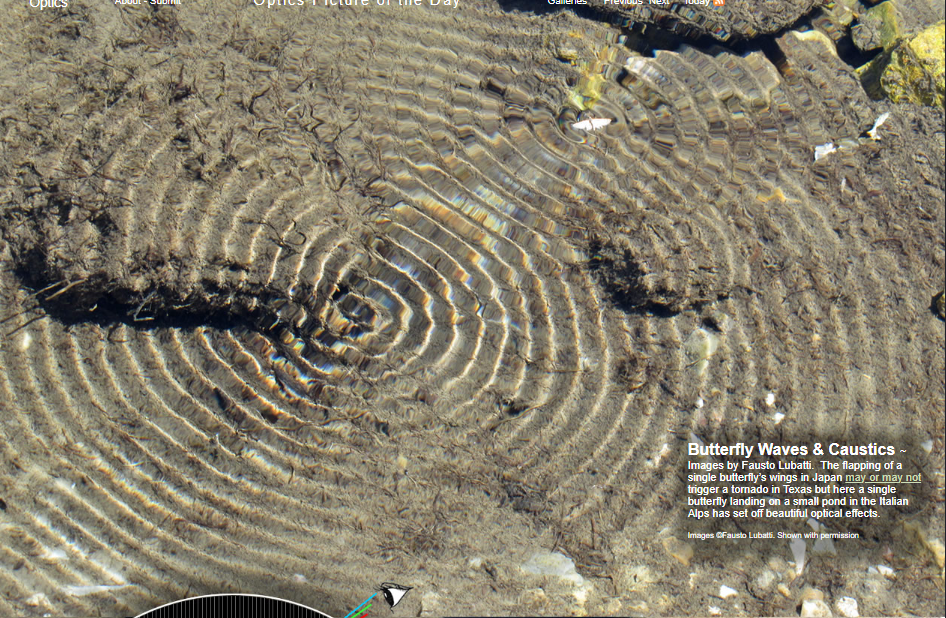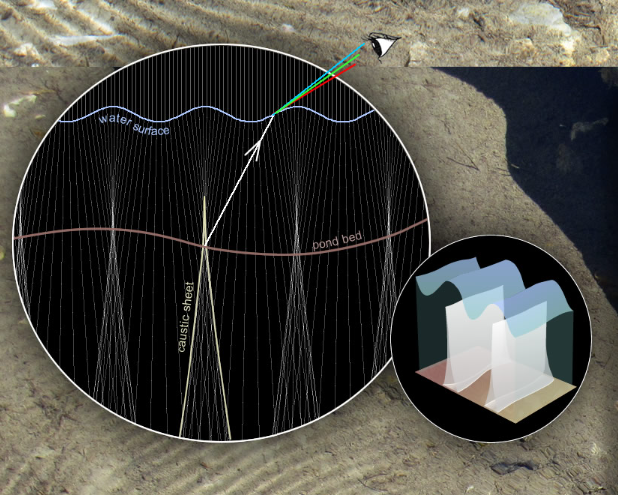OPOD - Butterflies & caustics
OPOD - Butterflies & Caustics: Unveiling Nature's Optical Wonders
Have you ever witnessed the mesmerizing optical effects that can be triggered by a simple butterfly landing on a serene pond? In the enchanting Italian Alps, Fausto Lubatti captured stunning images of a butterfly's gentle touch on the water's surface, revealing a world of intricate patterns and spectral colors. These captivating phenomena, known as butterfly waves and caustics, highlight the captivating interplay between light and water. Let's delve deeper into this magical display of nature's optical wonders.
Unraveling Butterfly Waves and Caustics
When the delicate wings of a butterfly delicately touch the water, it sets off a series of concentric waves that ripple outward. These gentle disturbances create a mesmerizing pattern that spreads across the pond's surface, captivating any observer fortunate enough to witness this spectacle.
However, the most prominent feature of Lubatti's images is not the waves themselves but the radiant circles that appear near the center. These luminous circles are not caused by the waves; rather, they are known as bright line caustics. These caustics are formed due to the phenomenon of refraction at the wavy water surface.
The Magic of Refraction and Dispersion
Refraction occurs when light waves pass through a medium with varying densities, such as the interface between air and water. In this case, the wavy surface of the pond acts as a lens, bending and redirecting the sunlight that reaches it. This bending of light rays leads to spatial discontinuities, resulting in clusters where pairs of rays intersect.
At these intersections, a concentration of light occurs, forming a caustic surface. Unlike images produced by lenses, caustics are always sharp, highlighting the distinct boundaries where light rays cross or do not cross at all. In Lubatti's images, the butterfly's presence enhances the refraction effect, creating well-ordered and captivating caustic surfaces.
Unveiling Nature's 'Focusing' Phenomenon
Caustics can be thought of as nature's way of focusing light. They are exquisite manifestations of spatial discontinuities in light ray behavior, revealing the intricate dance between light and matter. The butterfly's gentle touch on the pond's surface causes the refracted sun rays to deflect and form volumes where pairs of rays intersect.
These intersections give rise to the formation of caustic surfaces, which can be observed as bright circles on the pond bed. The radiant colors that adorn these circles result from the dispersion of white light. When viewed through a sharply tilted wave surface, the white light is dispersed into its individual spectral colors, creating a mesmerizing display of hues.
Unveiling the Intersection of Caustic Sheets
To further appreciate the intricate beauty of caustics, it is crucial to understand their intersection with the pond bed. In Lubatti's images, the bright circles observed at the center and lower left are precisely these intersections. The caustic sheets, formed by the concentration of light at specific points, intersect with the bed, resulting in these luminous circles.
The interplay between light, water, and the contours of the pond bed creates a stunning visual spectacle that enchants and captivates. It is a testament to the awe-inspiring complexity of nature's optical phenomena, inviting us to delve deeper into the mysteries of our world.
Conclusion: A Glimpse into Nature's Optical Symphony
Fausto Lubatti's extraordinary images of butterfly waves and caustics transport us into a realm where light and water dance in perfect harmony. Through the gentle touch of a butterfly's wings, we witness the formation of concentric waves, accompanied by radiant caustics that paint the pond bed with vivid colors.
These optical wonders, born from the interplay of refraction, dispersion, and intersecting caustic surfaces, remind us of the boundless beauty and complexity that surrounds us. They serve as a reminder to embrace the marvels of the natural world and continue our exploration of the captivating interplay between light and matter.
Immerse yourself in the world of butterfly waves and caustics, and let nature's optical symphony unfold before your eyes.

Butterfly Waves & Caustics ~ Images by Fausto Lubatti. The flapping of a single butterfly’s wings in Japan may or may not trigger a tornado in Texas but here a single butterfly landing on a small pond in the Italian Alps has set off beautiful optical effects.
Images ©Fausto Lubatti. Shown with permission

The tiny butterfly has landed on the water surface at top right creating a set of outgoing concentric water waves.
The more obvious bright circles centred near the image middle are not waves, they are bright line caustics on the pond bed and produced by refraction at the wavy water surface.
The spectral colours are the images of the caustics refracted and dispersed into individual wavelengths as they emerge at the wavy and sometimes severely sloping water surface. Here the refraction effect is marked and, thanks to the butterfly, well ordered. The same effect can sometimes be seen in a shallow sea as intense flashes of coloured light.
Caustics are Nature’s ‘focusing’. Unlike images from our lenses, caustics are always sharp. They mark spatial discontinuities in light ray behaviour. The butterfly waved pond surface refracts sun rays. Regions where the surface is convex deflect rays to form volumes where pairs of rays cross. At the volume edges the ray crossings cluster and there is a corresponding concentration of light – a caustic surface. Elsewhere there are no rays crossing. The caustic surface is at the boundary of two spaces where pairs of rays cross or do not cross at all.
The intersection of the caustic surfaces with the pond bed gives the bright circles seen at the upper picture’s centre and at lower left.
The colours result when the white caustic is viewed through a sharply tilted wave surface and the white is dispersed into spectral colours.

The bright circles are on the pond bed. They are the intersections of caustic sheets with the bed.
Note: this article has been automatically converted from the old site and may not appear as intended. You can find the original article here.
Reference Atmospheric Optics
If you use any of the definitions, information, or data presented on Atmospheric Optics, please copy the link or reference below to properly credit us as the reference source. Thank you!
-
<a href="https://atoptics.co.uk/blog/opod-butterflies-caustics/">OPOD - Butterflies & caustics</a>
-
"OPOD - Butterflies & caustics". Atmospheric Optics. Accessed on April 24, 2024. https://atoptics.co.uk/blog/opod-butterflies-caustics/.
-
"OPOD - Butterflies & caustics". Atmospheric Optics, https://atoptics.co.uk/blog/opod-butterflies-caustics/. Accessed 24 April, 2024
-
OPOD - Butterflies & caustics. Atmospheric Optics. Retrieved from https://atoptics.co.uk/blog/opod-butterflies-caustics/.